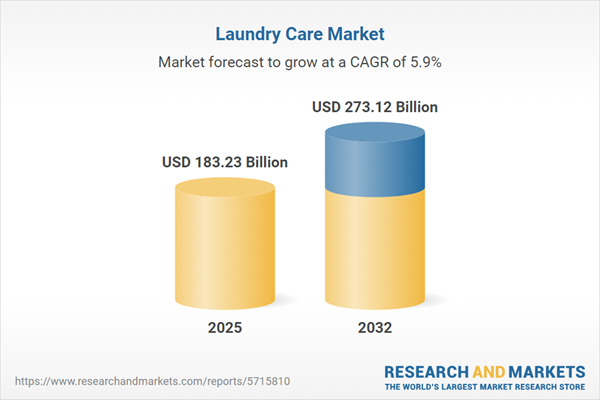Speak directly to the analyst to clarify any post sales queries you may have.
The laundry care market is rapidly evolving, driven by substantial shifts in consumer preference, sustainability mandates, and the increasing integration of digital technologies across value chains. Industry leaders are adapting product innovation and distribution approaches to meet changing regulatory requirements and competitive pressures, positioning themselves for continued growth in a dynamic landscape.
Laundry Care Market Snapshot
The Laundry Care Market grew from USD 173.05 billion in 2024 to USD 183.23 billion in 2025. It is expected to continue growing at a CAGR of 5.86%, reaching USD 273.12 billion by 2032.
Scope & Segmentation of the Laundry Care Market
- Product Types: Fabric Softeners & Conditioners, Laundry Detergents, Laundry Sanitizer, Stain Removers
- Product Forms: Liquid, Pods/Capsules, Powder
- End-User Segments: Commercial (Healthcare Facilities, Hotels, Laundromats), Industrial, Residential
- Distribution Channels: Offline Retail (Convenience Stores, Supermarkets & Hypermarkets), Online Retail (Brand-Owned Websites, eCommerce Platforms)
- Regional Coverage: Americas (United States, Canada, Mexico, Brazil, Argentina, Chile, Colombia, Peru), Europe, Middle East & Africa (United Kingdom, Germany, France, Russia, Italy, Spain, Netherlands, Sweden, Poland, Switzerland, United Arab Emirates, Saudi Arabia, Qatar, Turkey, Israel, South Africa, Nigeria, Egypt, Kenya), Asia-Pacific (China, India, Japan, Australia, South Korea, Indonesia, Thailand, Malaysia, Singapore, Taiwan)
- Leading Companies: Alicorp S.A.A., Amway Corporation, Anuspa Heritage Products Pvt Ltd, AoGrand Intl Group Inc., Arcot Manufacturing Corporation, Blue Moon (China) Co., Ltd., Bombril S.A., ChemWorks Group, LLC, Church & Dwight Co., Inc., Colgate-Palmolive Company, E.U.D.GROUP, a.s., Godrej Consumer Products Limited, Golrang Industrial Group, Guangdong Youkai Technical Co., Ltd., Henkel AG & Co. KGaA, Kao Corporation, LG Household & Health Care Ltd., Lion Corporation, Mibelle Group, Nirma Limited, Persán Polska, S.A., Procter & Gamble Company, Reckitt Benckiser Group PLC, RSPL Group Pvt. Ltd., Shanghai Hutchison White Cat Co. Ltd., STPP Group, The Clorox Company, Tropical Products, Inc., Unilever PLC, Wipro Enterprises (P) Ltd.
Key Takeaways and Strategic Insights
- Growth in the laundry care market is anchored by consumer demand for sustainable, high-performance products and transparent ingredient sourcing.
- Brands are advancing concentrated formulations and refillable systems to reduce environmental impact and meet evolving regulatory expectations.
- Digital integration—through connected appliances, mobile applications, and subscription services—enables brands to capture consumer insights, improve engagement, and support smarter dosing practices.
- Product formats such as pods and capsules are gaining favor among urban and convenience-oriented consumers, while powdered solutions address specific regional and cost concerns.
- Segmented strategies tailored to residential, commercial, and industrial end-users are optimizing packaging, efficacy, and compliance requirements for diverse application needs.
- Omnichannel distribution, with a blend of physical retail presence and expanding eCommerce, strengthens market access and responsiveness to shifting buying patterns.
Tariff Impact on Supply Chains and Operations
Recent tariff revisions in the United States have compelled supply chain and procurement teams within the laundry care sector to adjust sourcing tactics and explore supplier alternatives in key global regions. To manage increased overhead, companies are streamlining manufacturing, leveraging shared warehousing, and adopting nearshoring initiatives, all while enhancing customs and trade compliance for cost efficiency and resiliency.
Methodology & Data Sources
This report integrates qualitative interviews with senior R&D and supply chain leaders, alongside quantitative surveys targeting end users and channel partners. Additional secondary research draws upon regulatory filings, patent databases, and industry publications, providing a multidimensional view of the market’s evolution and competitive activity.
Why This Report Matters
- Empowers decision makers to steer product innovation, distribution, and supply chain strategy in an increasingly regulated and sustainability-driven market.
- Informs market positioning and investment allocation through clear segmentation and actionable insights into emerging consumer trends and technology adoption.
Conclusion
As sustainability, connectivity, and operational agility converge as central drivers, the laundry care market continues to evolve. Organizations leveraging these dynamics with strategic clarity will secure a competitive advantage and realize long-term growth opportunities.
Additional Product Information:
- Purchase of this report includes 1 year online access with quarterly updates.
- This report can be updated on request. Please contact our Customer Experience team using the Ask a Question widget on our website.
Table of Contents
3. Executive Summary
4. Market Overview
7. Cumulative Impact of Artificial Intelligence 2025
Companies Mentioned
The companies profiled in this Laundry Care market report include:- Alicorp S.A.A.
- Amway Corporation
- Anuspa Heritage Products Pvt Ltd
- AoGrand Intl Group Inc.
- Arcot Manufacturing Corporation
- Blue Moon (China) Co., Ltd.
- Bombril S.A.
- ChemWorks Group, LLC
- Church & Dwight Co., Inc.
- Colgate-Palmolive Company
- E.U.D.GROUP, a.s.
- Godrej Consumer Products Limited
- Golrang Industrial Group
- Guangdong Youkai Technical Co., Ltd.
- Henkel AG & Co. KGaA
- Kao Corporation
- LG Household & Health Care Ltd.
- Lion Corporation
- Mibelle Group
- Nirma Limited
- Persán Polska, S.A.
- Procter & Gamble Company
- Reckitt Benckiser Group PLC
- RSPL Group Pvt. Ltd.
- Shanghai Hutchison White Cat Co. Ltd.
- STPP Group
- The Clorox Company
- Tropical Products, Inc.
- Unilever PLC
- Wipro Enterprises (P) Ltd.
Table Information
| Report Attribute | Details |
|---|---|
| No. of Pages | 195 |
| Published | November 2025 |
| Forecast Period | 2025 - 2032 |
| Estimated Market Value ( USD | $ 183.23 Billion |
| Forecasted Market Value ( USD | $ 273.12 Billion |
| Compound Annual Growth Rate | 5.8% |
| Regions Covered | Global |
| No. of Companies Mentioned | 31 |









